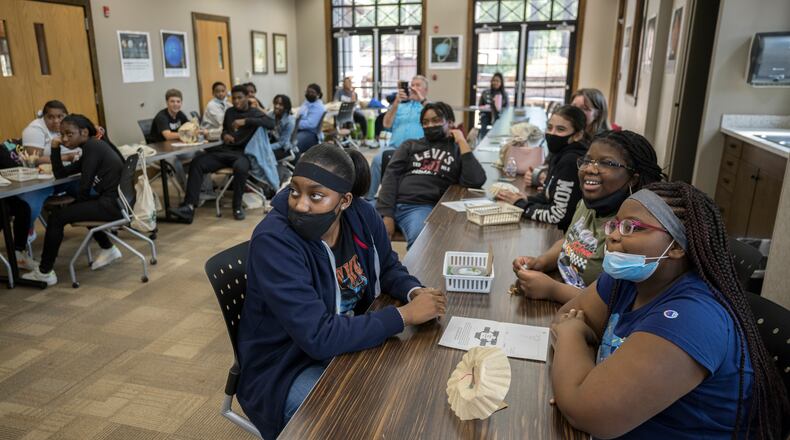SWAINSBORO — At a recent town hall meeting, the president of East Georgia State College told employees the school must do a better job of enrolling and retaining students.
Enrollment was down nearly 17% last fall to about 2,000 students — the sharpest decline of any public college or university in the state. The consequences of a continuing decline could include losing state funding, which faculty fear could mean job cuts. They also worry it may result in the closure of some smaller colleges.
“This truly is a game of inches,” said David Schecter, who became the college’s president in January. “One or two students at a time each day can really help us as a college.”
College enrollment nationwide has declined in recent years, a troubling statistic for business leaders who want educated young people to land good jobs or create jobs in high-paying and emerging industries. The state currently needs more college-educated nurses, teachers and software engineers and there are projections the talent gap may grow in the coming years. Georgia educators believe the decline will continue amid projections of decreasing birthrates and fewer students graduating from high school.
East Georgia State is one of six University System of Georgia schools with enrollment declines greater than 20% over the last five years.
Most of those schools are state colleges focused on offering two-year associate degrees located outside metro Atlanta. They receive less state funding from a funding formula largely based on enrollment.
Schecter, who met with state lawmakers a day earlier, told the workers if the college can increase enrollment, “I think there will be a little bit more help from the state coming our way.”
But, he continued, “If we can’t make that argument in a year or two, I think that’s more problematic.”
Credit: Stephen B. Morton for The Atlanta Journal-Constitution
Credit: Stephen B. Morton for The Atlanta Journal-Constitution
Rural challenges
Schecter attributes much of the decline at his school to slow population growth in Emanuel County and surrounding areas. The county’s population increased less than 1% over the last decade, federal data shows. Georgia’s population increased nearly 11% during the same time frame.
Across Georgia, the coronavirus pandemic has exacerbated the enrollment challenges, educators say.
Georgia Gwinnett College had nearly 13,000 students the year before the pandemic, its highest ever, said Michael Poll, its vice president for enrollment management.
“We were flying high,” he said.
Enrollment has declined there by nearly 2,000 students since, state data shows.
Recruiters were initially unable to visit some high schools after they went to remote learning. High school students had less access to counselors to guide them through the college application process. Many Georgia students didn’t complete the detailed form to apply for federal financial aid.
“A lot of the students were on their own,” Poll said.
And since the pandemic, more young people have entered the workforce to support their families, research shows. Young people working in full-time jobs more than a year after graduating from high school are less likely to attend college, noted Matt Smith, senior policy analyst of the nonprofit Georgia Partnership for Excellence in Education.
“The financial barriers have become overwhelming for a lot of low-income students,” said Dana Rickman, the partnership’s president.
East Georgia State students say that before the pandemic, the main campus had many more students. The atmosphere now, they say, isn’t the same.
“The school is set up for a lot of students,” said Ayana Robinson, 20, from Atlanta. “It is set up for a lot of people to come together. It’s just COVID has prevented it.”
Credit: Stephen B. Morton for The Atlanta Journal-Constitution
Credit: Stephen B. Morton for The Atlanta Journal-Constitution
Recruiting efforts
University System leaders have instituted some adjustments intended to make the college application process easier, such as decisions to waive the ACT or SAT as part of admissions requirements at most of its schools. But the adjustments have resulted in unintended consequences for its smaller schools, educators say. Many students that may have enrolled at an East Georgia State have instead chosen a larger school, like Georgia Southern University.
Smith suggested the University System create public online curriculum for all of its schools. Georgia Tech’s enrollment has increased nearly 50% over the last five years as it has added more online courses geared toward professionals.
“Institutions need to be more proactive to say ‘OK, we need to figure out ways to recruit to bring these people back or have them enroll for the first time,’” Smith said.
Georgia Gwinnett College ramped up sessions at some local high schools in which the college offered on-site acceptance to qualified students.
East Georgia State administrators say they’re thinking of ideas, like more online courses. The school’s main campus, midway between Augusta and Savannah, has the look of a resort, with its 18-hole disc golf course amid skyscraping pine trees. Recruiters sell students on its serene atmosphere. They also note it has the lowest tuition in the state system, $1,425 a semester.
Most importantly, they say, it is a place that can prepare young people who weren’t the best high school students for a four-year university.
Liberal arts student Aaron Penn said he never received an A at his Fulton County high school. Here, Penn said he receives more attention from professors like Antré Drummer, who’s become a mentor, and it’s paying off in the classroom. Penn recalled joyfully entering Drummer’s office after getting an A in one class.
“It’s a school for diamonds in the rough,” said Penn, 21, an aspiring film producer.
Credit: Eric Stirgus
Credit: Eric Stirgus
LaFredrick Gilchrist, 19, a first-year student from Augusta, said he constantly gets emails from faculty checking on him. Robinson recalled a message that said: “You’re doing really good in your classes. Keep pushing.”
The school’s retention rate hovers around 50%, slightly lower than the systemwide average for students seeking associate degrees. The college offers daily tutoring.
East Georgia State workers are now doing more recruiting in Atlanta, Macon and Savannah. Schecter, who makes some recruiting trips, sees signs of hope. Fall applications are up 43%, he said.
The University System of Georgia consolidated several mostly smaller colleges about a decade ago in a cost-cutting measure. Kathy Knutzen, who came out of retirement to help Schecter, noted research concluding some U.S. colleges will close in the coming years if the enrollment decline continues.
“We are not going to be on that list,” she said.
About the Author
Keep Reading
The Latest
Featured





